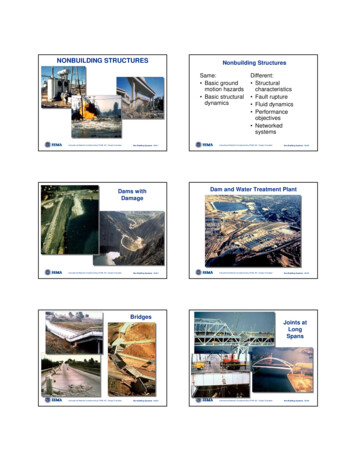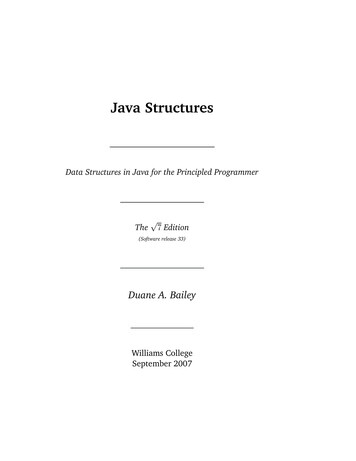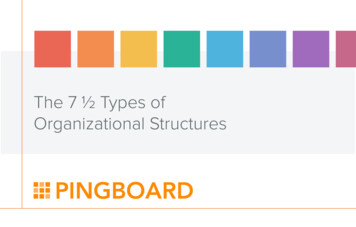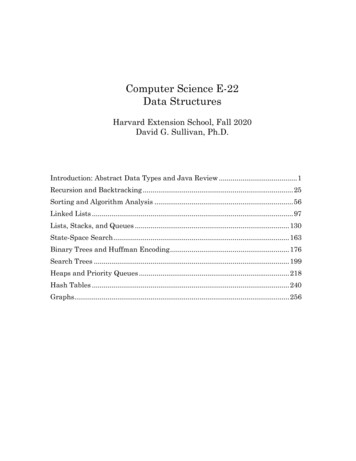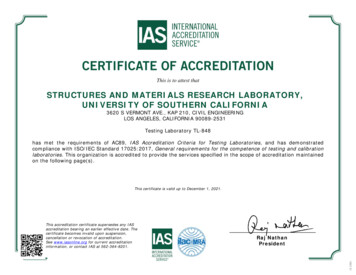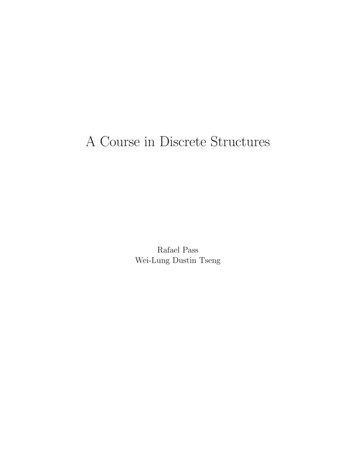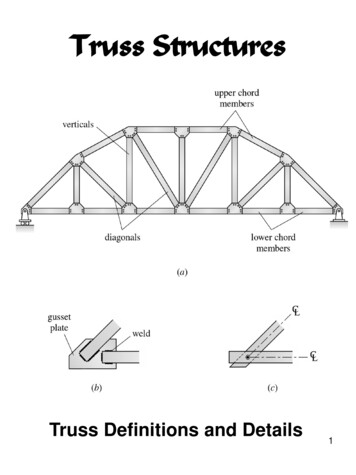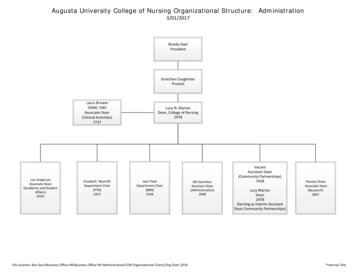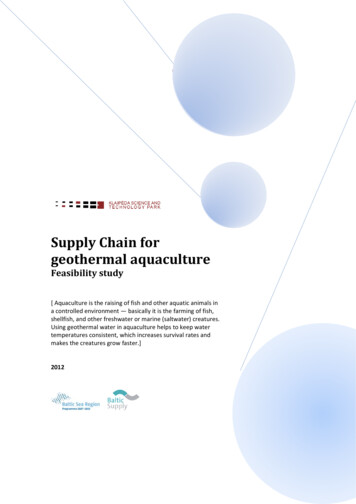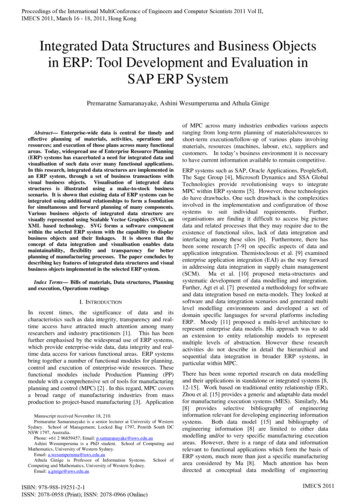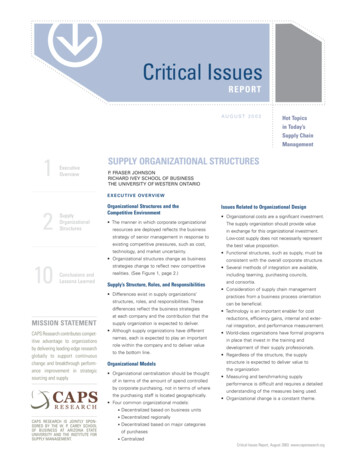
Transcription
Critical IssuesREPORTAUGUST 20 031ExecutiveOverviewHot Topicsin Today’sSupply ChainManagementSUPPLY ORGANIZATIONAL STRUCTURESP. FRASER JOHNSONRICHARD IVEY SCHOOL OF BUSINESSTHE UNIVERSITY OF WESTERN ONTARIOE X E C U T I V E OV E RV I E W2SupplyOrganizationalStructuresOrganizational Structures and theCompetitive Environment The manner in which corporate organizationalin exchange for this organizational investment.Low-cost supply does not necessarily represent Organizational structures change as businessstrategies change to reflect new competitiverealities. (See Figure 1, page 2.)Supply’s Structure, Roles, and Responsibilities Differences exist in supply organizations’structures, roles, and responsibilities. Thesedifferences reflect the business strategiesat each company and the contribution that theMISSION STATEMENTCAPS Research contributes competitive advantage to organizationsby delivering leading-edge researchglobally to support continuouschange and breakthrough performance improvement in strategicsourcing and supply.supply organization is expected to deliver. Although supply organizations have differentthe best value proposition. Functional structures, such as supply, must beconsistent with the overall corporate structure. Several methods of integration are available,including teaming, purchasing councils,and consortia. Consideration of supply chain managementpractices from a business process orientationcan be beneficial. Technology is an important enabler for costreductions, efficiency gains, internal and external integration, and performance measurement. World-class organizations have formal programsnames, each is expected to play an importantin place that invest in the training androle within the company and to deliver valuedevelopment of their supply professionals.to the bottom line.Organizational Models Organizational centralization should be thoughtof in terms of the amount of spend controlledby corporate purchasing, not in terms of wherethe purchasing staff is located geographically. Four common organizational models: CAPS RESEARCH IS JOINTLY SPONSORED BY THE W. P. CAREY SCHOOLOF BUSINESS AT ARIZONA STATEUNIVERSITY AND THE INSTITUTE FORSUPPLY MANAGEMENT.The supply organization should provide valuestrategy of senior management in response totechnology, and market uncertainty.Conclusions andLessons Learned Organizational costs are a significant investment.resources are deployed reflects the businessexisting competitive pressures, such as cost,10Issues Related to Organizational Design Regardless of the structure, the supplystructure is expected to deliver value tothe organization Measuring and benchmarking supplyperformance is difficult and requires a detailedunderstanding of the measures being used. Organizational change is a constant theme.Decentralized based on business units Decentralized regionally Decentralized based on major categoriesof purchases CentralizedCritical Issues Report, August 2003: www.capsresearch.org
Critical IssuesREPORT2SUPPLY ORGANIZATIONAL STRUCTURESINTRODUCTIONThis white paper resulted from presentations and discussions at aCAPS Research Best/Good Practices Forum hosted by MasterFoods U.S.A. on May 14and 15, 2003. The topic of the forum was supply organizational structures, with anemphasis on organizational design, technology applications, process improvements,and employee training and development.The following companies participated in the forum: General Mills, MasterFoods U.S.A.,Novartis, The St. Paul Companies, and United Technologies Corporation. These companies provided a diversity of industry context to the discussions. Table 1 lists the participating organizations and provides a brief overview of each.TA B L E 1 : PA RT I C I PAT I N G O R G A N I Z AT I O N SCOMPANYF I G U R E 1 : O R G A N I Z AT I O N A L D E S I G NGeneral MillsA consumer products company with brands across a wide range of foodcategories, including cereals, snack foods and baking products. Total revenuesof approximately 11 billion.MasterFoods U.S.A.A consumer products company that produces snack food, pet food, and mainmeal food. Total employment of approximately 7,500 people.NovartisCorporateStrategyThe St. Paul CompaniesExternalEnvironmentUnited Technologies Corp.OrganizationalStructurePRIMARY BUSINESSAn international company that develops, manufactures, and distributespharmaceuticals and consumer health products. Total revenues of approximately 21 billion.A provider of commercial property liability and specialty insurance. Totalrevenues of approximately 9 billion.A global technology corporation manufacturing products in the aerospace andbuilding products industries. Total revenues of approximately 28 billion.W H AT I S I N A N A M E ?The manner in which corporate organizational resources aredeployed reflects the business strategy of senior management in response to existingcompetitive pressures, such as cost, technology, and market uncertainty. Organizationalstructures change as business strategies change to reflect new competitive realities.This relationship is reflected in Figure 1.PerformanceThe selection of a particular organizational structure will influence how well a firm ispositioned to compete and ultimately, its performance. Firms in the same industry,competing for the same customers, may select completely different structures, but beequally successful. The challenge is balancing external factors with the internal capabilities of the organization.Critical Issues Report, August 2003: www.capsresearch.org
Critical IssuesREPORT3Innovations in information technology, competitive pressures to reduce overheads, andprograms designed to provide employees with more independence when making decisions have contributed to the development of new and innovative approaches to organizational design. The supply function is on the forefront of organizational evolution and itis a logical candidate for integration with other functions. Meanwhile the trade-offsbetween centralized and decentralized supply structures are constantly under scrutiny.Change is commonplaceas executives realignstructure, roles, andresponsibilities to fit thebusiness objectivesand priorities.The challenge of every supply organization should be to support corporate goals andstrategies. For example, the mission of the Commercial Division at MasterFoods is to:“Ensure continual supply of quality goods and services which deliver a sustainablecompetitive business advantage, consistent with the overall needs of the business.”Effective deployment of resources within the supply organization and the supplier network is necessary to make this objective a reality. Consequently, the organizationalstructure of the supply function, and its roles and responsibilities, reflect the overallcorporate structure and the unique circumstances within the company. There is nostandard “cookie cutter” approach to supply organizational design. Change is commonplace as executives realign structure, roles, and responsibilities to fit the businessobjectives and priorities.Among the firms participating at the forum, several differences existed with respect tothe supply organizations’ structures, roles, and responsibilities. These differencesreflected the business strategies at each company and the contribution that the supplyorganization was expected to deliver. No two companies at the forum used the samename for its supply organization, yet each was expected to play an important role within the company and to deliver value to the bottom line. For example, the CommercialDivision at MasterFoods is responsible for everything bought at the company on aworldwide basis. Commercial Division associates are relied upon to manageMasterFoods’ risk through strategic sourcing, contracting, hedging techniques, andsupplier diversity to ensure maximum value for money in the procurement of all goodsand services. The important role of the Commercial Division at MasterFoods reflectedthe maxim of the company’s founder: “What is well bought is well sold.”Critical Issues Report, August 2003: www.capsresearch.org
Critical IssuesREPORTO R G A N I Z AT I O N A L ST R U C T U R E4Organizational structures can take a variety of forms.In the past, centralized organizational structures were regarded as those in which thepurchasing staff was in a single physical location, typically the head office. Meanwhile,decentralized structures placed supply within the business units or plants. Today, physical location may have little to do with reporting relationships. The ability to place corporate supply managers with key user groups has been supported through technologicaldevelopments. There was general consensus among the group that organizational cen-tralization should be thought of in terms of the amount of spend controlled by corporate purchasing, not in terms of where the purchasing staff was located geographically.Decentralization can occur on four levels. The first is the business unit level. For example, United Technologies has a number of business units, including Pratt & Whitney,Hamilton Sunstrand, Sikorsky, Otis, and Carrier. Each business unit has a separate supply group, which is supported by a 55-person corporate supply group. This structureallows the divisional supply organizations to focus on their division’s specific needs, sothat priorities and resources can be established on a business-unit level. Meanwhile,common requirements and corporatewide initiatives can be addressed through the corporate purchasing group.A second approach is regional decentralization. Because of differences across geographic regions, some large companies combine plants or strategic business units(SBUs) under a regional structure. MasterFoods is an example of a regional structure,with responsibility for the North American business development teams. TheCommercial Division reflects the regional corporate structure.A third approach separates major categories of purchases. The significance of indirectpurchases at Novartis warrants the separation of direct and indirect strategic sourcingorganizations. The indirect strategic purchasing group is able to adopt processes andmetrics that reflect the characteristics of its spend categories. Regional decentralizationis also easier to facilitate for indirect purchases, since the strategic sourcing group onthe direct side requires centralization and standardization of supply.The fourth approach, a centralized model, can still incorporate certain features thatprovide flexibility and responsiveness. Such organizations do not necessarily resemblethe single site, centralized purchasing organizations of decades past. Co-locationwith user groups and separation of strategic purchasing and materials managementactivities can allow a centrally coordinated reporting structure to be geographicallydispersed. Communication, control, and coordination are facilitated through informationtechnology. General Mills has adopted a centralized corporate structure, including aworldwide sourcing group. Its organizational structure is divided across major spendCritical Issues Report, August 2003: www.capsresearch.org
Critical IssuesREPORT5categories, such as commodities, capital & MRO, ingredients & packaging, andmarketing & indirect — each with a global mandate.While approaches to organizational structure vary, three underlying themes exist. First,Much like the returnsthey contemplate wheninvesting in a new pieceof equipment, the seniormanagement mustcontinually weigh thecosts and benefits of itsorganizational resourcesfunctional structures, such as supply, must be consistent with the overall corporatestructure. The elements of an organizational structure are supportive and reinforcing,much like a bio/ecosystem, and the relationship between supply with the other mainfunctions must be carefully balanced. Any changes in one element require accompanying changes in others. Therefore, when attempting to understand why a particular supply organizational structure has been adopted, it is useful to examine this issue fromthe perspective of the overall corporate structure.Second, change is a constant theme. Occasionally there are major changes in structureor wholesale changes in responsibilities. However, there is almost constant changeresulting from the “tinkering” that occurs in an organization. These minor changes are aresult of senior management initiatives, new leadership, consultant studies, and industry trends, to name only a few. In the end, organizations don’t remain static for verylong, and successful managers must be adept at handling and managing change.A third theme relates to the objectives of the supply organizations. The investment inpeople represents a significant cost. Much like the returns they contemplate wheninvesting in a new piece of equipment, the senior management must continually weighthe costs and benefits of its organizational resources. The discussion at the forum rec-ognized that organizational costs are a significant investment and that the supply organization should provide value in exchange for that organizational investment. Low-costsupply does not necessarily represent the best value proposition.VA L U E - B AS E D M E T R I C SA major challenge facing the firms that participated in theforum was establishing appropriate metrics, or as proposed by General Mills: “Measuringtotal value to get total value.” The participants discussed two aspects related to metrics.The first aspect related to consistency between supply activities and performancemeasures. For example, the CPO at Norvartis changed the metrics of the strategicsourcing group to reflect the indirect nature of the spend that it managed.A second aspect, and one that the participants at the forum identified as an area for further collaboration, was benchmarking. Several of the forum participants also take part inCAPS Research benchmarking projects. Although these projects include companiesfrom similar
ORGANIZATIONAL STRUCTURE Organizational structures can take a variety of forms. In the past, centralized organizational structures were regarded as those in which the purchasing staff was in a single physical location, typically the head office. Meanwhile, decentralized structures placed supply within the business units or plants. Today, physi-File Size: 265KBPage Count: 11
